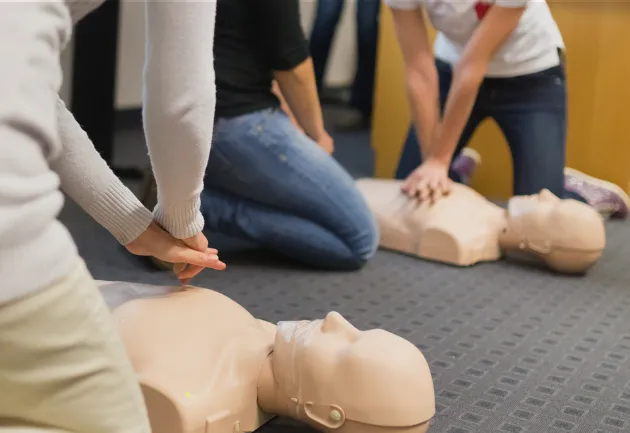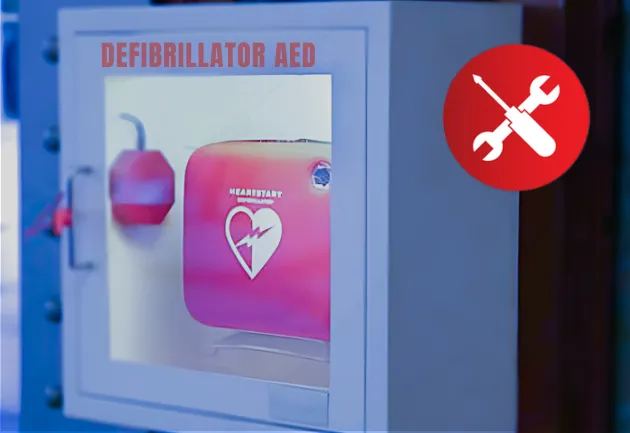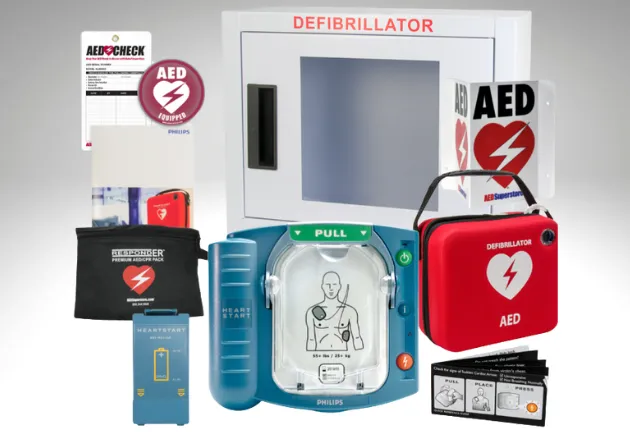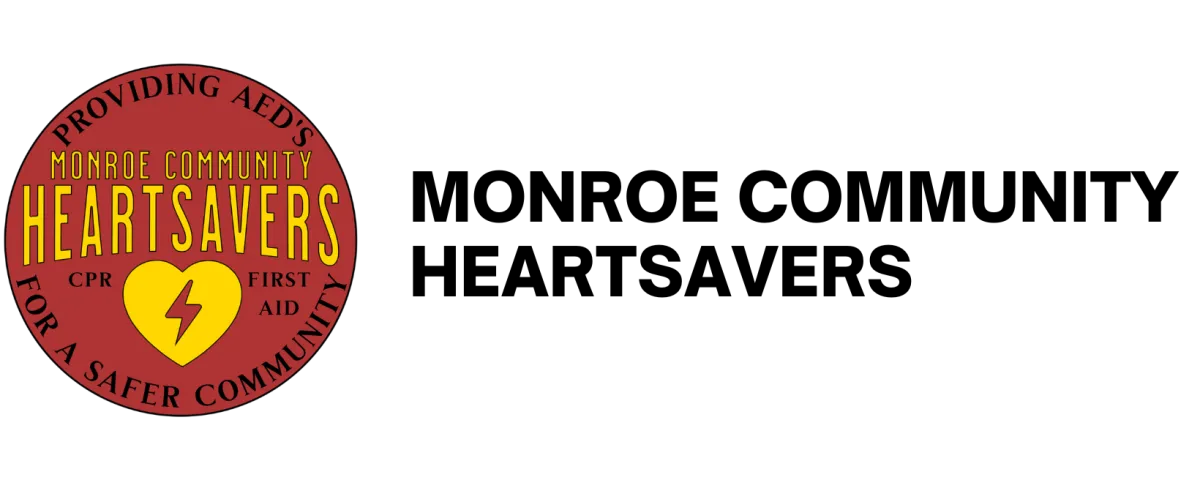How Can You Make an Impact?
Your contribution—big or small— will help place more AEDs, organize additional training sessions, and strengthen our overall readiness.
Weather you want to donate, learn the skill of CPR/ AED use, or even purchase an AED for your space, your making a decision to positively impact your community!
See our full list of ways to contribute below!

Donate
Make a tax-deductible gift to fund new AED placements and training programs.
Our partnership with the Community Foundation of Monroe County ensures your donation is securely processed and used directly within our community.



Host a Training
Bring CPR/AED/ First Aid instruction to your workplace, neighborhood, or group. We offer both American Heart Association courses as well as Friends and Family courses.

Volunteer
Monroe Community Heartsavers is always looking to get the community involved. Assist with fundraising events, help run local training sessions, or even sit on our Board!



AED Maintenance Program
Don't get caught off guard in an emergency with a failing AED. Be the hero who’s prepared - sign up for our AED maintenance program and guarantee readiness when every second counts.

Purchase an AED
Secure a Philips HeartStart OnSite AED for your business or public space. Your order equips your location with a reliable device and helps support our mission with additional AED placements and CPR/AED training across Monroe County.

AED-Frequently Asked Questions
What Is Sudden Cardiac Arrest?
Sudden Cardiac Arrest is a sudden and unexpected abnormality of the heart’s electrical system which causes the heart to stop beating normally. When this occurs, blood stops flowing properly and the victim becomes unconscious and pulseless. The BEST way to restore their heart rhythm is by administering a shock immediately.
Is Cardiac Arrest The Same As a Heart Attack?
No. A heart attack (myocardial infarction) occurs when the heart’s blood supply is reduced or blocked causing the heart muscle to become injured and start to die. During a heart attack, the victim is conscious. In fact, the victim may complain about symptoms such as chest pain, difficulty breathing, or left arm pain
Cardiac Arrest is an electrical problem in the heart which causes the heart to beat in an irregular, inefficient manner causing the blood to not circulate to the brain appropriately, resulting in an unconscious victim.
Victims of a heart attack have a pulse but but cardiac arrest victims do not.
You don’t have to remember these distinctions. When the AED instructs you to put the pads on the victim, it will sense the heart rhythm and determine the best steps to take, giving you guidance all along the way.
When Should You Use An AED?
If a person collapses or loses consciousness, and either doesn’t have a pulse or isn’t breathing properly, intervention is required.
Even if the victim is unconscious gasping for air or having seizures, use the AED.
Don’t worry about diagnosing the victim correctly. The Philips AED will analyze the heart rhythm and tell you to deliver a shock, if and only if the victim needs it.
All you need to do is open the AED and follow the clear, calm voice instructions.
Can An AED Hurt Someone?
No, not if you follow the instructions from the AED.
AEDs are designed to help people whose hearts have stopped working effectively.
If the AED instructs you to deliver a shock, the person you are helping is already clinically "dead".
Your actions with the AED can only help.
What If I Do It Wrong?
The Phillips Heartstart Onsite AED is designed to tell you exactly what you need to do. It keeps pace with what you are doing and adapts its instructions so that it doesn’t overwhelm, run ahead, or slow you down. If necessary, it will repeat the prompts, rephrasing them or adding additional instruction to help you understand.
Why Not Just Wait For First Responders To Arrive?
The best chance to survive cardiac arrest is if high quality compressions are given and the victim is shocked within 3–5 minutes of going into cardiac arrest.
Oftentimes, emergency responders can’t arrive within that small time frame, drastically reducing the victims chance of survival.
Do I Need Training To Use An AED?
Philips Heartstart Onsite AEDs are designed so that anyone can use them immediately. However, receiving training is still the best idea.
The more familiar you are with the signs of a cardiac arrest and the use of the AED, the more likely you are to be calm and helpful in an actual emergency.
Are There Liability Risks When Using An AED?
Liability is a valid concern for program administrators and potential rescuers.
All 50 states have Good Samaritan Laws that protect you.
We recommend that you understand your local laws in your area.
Do I Need To Perform Maintenance On My AED?
Annual maintenance is recommended as there are parts that need regular replacement, including the pads and battery.
Who Can Own An AED?
With the Phillips Heartstart Onsite AED being the ONLY AED in the U.S that doesn't require a prescription, anyone can own an AED.
Where Should I Place My AED?
Place your AED's in visible, accessible places. Choose locations that increase the chances of getting the AED to the person in cardiac arrest in less than three minutes.
Outside elevators, cafeterias, and reception areas are all good locations for AED's.
What Is Sudden Cardiac Arrest?
Sudden Cardiac Arrest is a sudden and unexpected abnormality of the heart’s electrical system which causes the heart to stop beating normally. When this occurs, blood stops flowing properly and the victim becomes unconscious and pulseless. The BEST way to restore their heart rhythm is by administering a shock immediately.
Is Cardiac Arrest The Same As a Heart Attack?
No. A heart attack (myocardial infarction) occurs when the heart’s blood supply is reduced or blocked causing the heart muscle to become injured and start to die. During a heart attack, the victim is conscious. In fact, the victim may complain about symptoms such as chest pain, difficulty breathing, or left arm pain
Cardiac Arrest is an electrical problem in the heart which causes the heart to beat in an irregular, inefficient manner causing the blood to not circulate to the brain appropriately, resulting in an unconscious victim.
Victims of a heart attack have a pulse but but cardiac arrest victims do not.
You don’t have to remember these distinctions. When the AED instructs you to put the pads on the victim, it will sense the heart rhythm and determine the best steps to take, giving you guidance all along the way.
When Should You Use An AED?
If a person collapses or loses consciousness, and either doesn’t have a pulse or isn’t breathing properly, intervention is required.
Even if the victim is unconscious gasping for air or having seizures, use the AED.
Don’t worry about diagnosing the victim correctly. The Philips AED will analyze the heart rhythm and tell you to deliver a shock, if and only if the victim needs it.
All you need to do is open the AED and follow the clear, calm voice instructions.
Can An AED Hurt Someone?
No, not if you follow the instructions from the AED.
AEDs are designed to help people whose hearts have stopped working effectively.
If the AED instructs you to deliver a shock, the person you are helping is already clinically "dead".
Your actions with the AED can only help.
What If I Do It Wrong?
The Phillips Heartstart Onsite AED is designed to tell you exactly what you need to do. It keeps pace with what you are doing and adapts its instructions so that it doesn’t overwhelm, run ahead, or slow you down. If necessary, it will repeat the prompts, rephrasing them or adding additional instruction to help you understand.
Why Not Just Wait For First Responders To Arrive?
The best chance to survive cardiac arrest is if high quality compressions are given and the victim is shocked within 3–5 minutes of going into cardiac arrest.
Oftentimes, emergency responders can’t arrive within that small time frame, drastically reducing the victims chance of survival.
Do I Need Training To Use An AED?
Philips Heartstart Onsite AEDs are designed so that anyone can use them immediately. However, receiving training is still the best idea.
The more familiar you are with the signs of a cardiac arrest and the use of the AED, the more likely you are to be calm and helpful in an actual emergency.
Are There Liability Risks When Using An AED?
Liability is a valid concern for program administrators and potential rescuers.
All 50 states have Good Samaritan Laws that protect you.
We recommend that you understand your local laws in your area.
Do I Need To Perform Maintenance On My AED?
Annual maintenance is recommended as there are parts that need regular replacement, including the pads and battery.
Who Can Own An AED?
With the Phillips Heartstart Onsite AED being the ONLY AED in the U.S that doesn't require a prescription, anyone can own an AED.
Where Should I Place My AED?
Place your AED's in visible, accessible places. Choose locations that increase the chances of getting the AED to the person in cardiac arrest in less than three minutes.
Outside elevators, cafeterias, and reception areas are all good locations for AED's.
